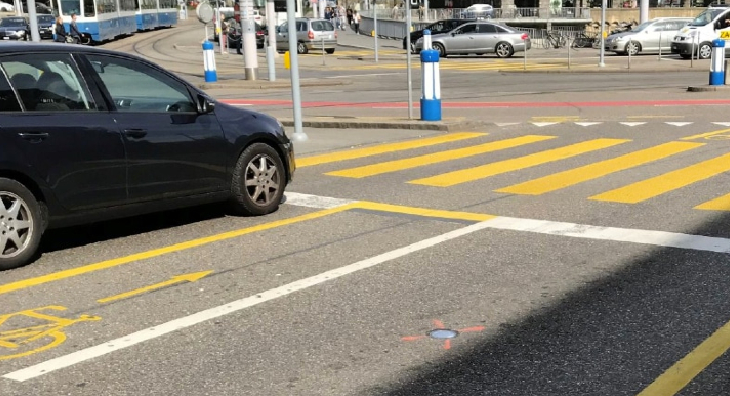Ground sensors make it easier for drivers to find parking spaces

The search for a parking space is a big nuisance for motorists. It costs not only time, but also gasoline and nerves. The many vehicles looking for parking spaces are also a problem for the city administration, as they contribute to congestion on the roads. Last but not least, the environment suffers from the increased emission of exhaust gases.
We at LTS AG have developed a solution that considerably simplifies the search for parking spaces: TAPS technology. Thanks to sensors, cars can be guided specifically to free parking spaces. The sensors are not only easy to install, but also energy-autonomous.
What problems does the search for a parking space cause?
In every city in the world, countless cars are on the road; once the drivers have reached their destination, they want to park their car. This is true for residents, visitors, commuters, tourists and other groups of people. But there is only a limited number of parking spaces. In Switzerland, according to statistics, there are particularly few. There are only 84 public parking spaces per 1000 cars in this country.
Um einen freien Stellplatz zu finden, müssen Autofahrer häufig längere Zeit suchen. Dafür fahren sie von einer Strasse in die nächste oder drehen Runden auf Parkplatzanlagen. Dieser Vorgang ist zunächst zeitraubend. Des öfteren befindet sich der Parkplatz zudem weit vom eigentlichen Ziel entfernt. Somit muss nach der Parkplatzsuche auch noch eine gewisse Strecke zu Fuss zurückgelegt werden.
Wer einen Termin hat, muss deshalb früher am Zielort eintreffen, um noch Zeit für die Parkplatzsuche zu haben. Auch Pendler müssen deutlich vor Arbeitsbeginn ankommen, da sie noch einen Parkplatz finden müssen. Und Hausbewohner suchen erst einen Stellplatz, bevor ihr wohlverdienter Feierabend beginnt.
The search for a parking space is therefore also extremely stressful for the nerves of those affected. This may cause them to become unfocused or even aggressive. And this can possibly result in accidents.
Impact on wallet and environment
It also makes itself felt financially if a driver regularly goes in search of a parking space. This is because his car consumes gasoline for which he has previously spent money at the gas station.
Equally serious is the effect that the search for a parking space has on the environment. On their unnecessary journeys, cars emit exhaust gases that pollute the atmosphere. In addition, the many people looking for a parking space create an additional burden on the often already crowded streets. Traffic jams form, which in turn cause further exhaust gases.
Smart solutions for finding parking spaces are able to prevent the emission of thousands of tons of CO2. With its TAPS technology, LTS AG is helping to make the search for parking spaces much easier.
The TAPS technology at a glance

The TAPS technology consists of the following three components:
ground sensor
Gateway
Software
A TAPS Sensor hat einen Durchmesser von 155 Millimetern und eine Höhe von 46 Millimetern. Ein relativ kleines Bohrloch genügt also, ihn in den Boden einzulassen. Zudem sind keine Verkabelungen nötig, da er sich selbst mit Energie versorgt. Daher ist seine Installation mit wenig Zeit und Aufwand verbunden – im Gegensatz zum Einlassen einer Induktionsschleife in den Boden.
If the TAPS sensor is in the asphalt, it detects whether there is a car above it. It sends this information to the TAPS Gateway which receives the data wirelessly. It then sends it to wherever the user wants it. This can either be a cloud service or an infrastructure.
Various options are available for transmission. For example, the data can be forwarded via WiFi, Bluetooth, LTE or optical interfaces. The user can then transmit them with the help of the TAPS Software auswerten. Sie stellt die gesammelten Daten auf übersichtliche Weise dar und erlaubt zudem umfassende Analysen.
For example, it is possible to determine how long a particular parking space is occupied on average. Parking operators can also calculate how much revenue they generate with individual parking spaces.
How do sensors specifically help in the search for parking spaces?

Dank der TAPS Sensoren ist zu jeder Zeit bekannt, ob ein Parkplatz belegt oder frei ist. Diese Information kann dafür genutzt werden, die Parkplatzsuche gezielt zu steuern. Dies geschieht beispielsweise über Displays am Strassenrand.
Auch die Signalisierung direkt am Parkplatz ist möglich. An einem grünen Licht erkennen Autofahrer etwa schon aus der Ferne, dass der Platz frei ist. Ein rotes Licht zeigt hingegen an, dass er belegt ist. Dieses System hat sich bereits in Parkhäusern bewährt, wo die TAPS Sensoren dank ihrer einfachen Installation ebenfalls sehr praktisch sind.
Da sie gegen Umwelteinflüsse geschützt sind, können sie auch bedenkenlos im Aussenbereich eingesetzt werden. Temperaturen von 65 Grad Celsius bis minus 25 Grad Celsius beeinflussen die Sensoren ebenfalls nicht.




)
)